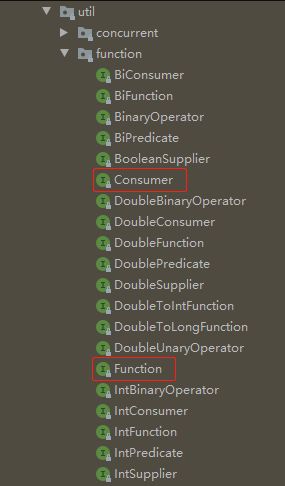JDK8辅助学习(二):Lambda表达式----常用的内置函数式接口
前言
当你在学习本文时,如果您还不了解 Lambda表达式的使用,请先跳转链接:JDK8新特性(一):Lambda表达式 ,来了解一下 Lambda表达式的基本使用。
从 Lambda表达式 一文,我们了解到使用Lambda表达式的前提条件,如下图所示。
由于使用条件的限制,明显不利于 Lambda表达式 的推广使用。为了能够让我们更方便的使用 Lambda 表达式,JDK为我们提供了大量的内置函数式接口。
内置函数式接口
它们都位于 java.util.function 包中,如下图所示。
常用的四大核心内置函数式接口,如上图所示。分别是 ①Supplier ②Consumer ③Function ④Predicate ,接下来我们来分别介绍这四大核心内置函数式接口
1.Supplier
@FunctionalInterface
public interface Supplier {
/**
* Gets a result.
*
* @return a result
*/
T get();
} 我们重点来看一下 get() 方法(Supplier也就这一个抽象方法)。
特点:①无参数 ②有返回值 --------->这种无参数 有返回值的接口,称之为"供给性接口"
Demo:
使用 Supplier接口作为方法参数类型,通过 Lambda表达式 来求出 int 数组中的最大值。
/**
* 利用 Supplier接口 1.无参 2.有返回值 特性,返回数组最大值
*/
public class SupplierDemo{
public static void main(String[] args){
int max = printMax(()->{
int[] arr = {19,63,15,84,56,38};
Arrays.sort(arr);//默认为升序排序
return arr[arr.length-1];
});
System.out.println("数组最大值为:"+max);
}
public static int printMax(Supplier supplier){
int max = supplier.get();//通过supplier.get() 方法,获得返回值
return max;
}
} 2.Consumer
@FunctionalInterface
public interface Consumer {
/**
* Performs this operation on the given argument.
*
* @param t the input argument
*/
void accept(T t);
} 我们重点来看一下 accept() 方法(该接口还有一个 andThen()方法)。
特点:①有参数 ②无返回值 --------->这种有参数 无返回值的接口,称之为"消费性接口"
Demo:
①使用 Consumer 接口作为方法参数类型,通过 Lambda表达式 来将传入的"Hello Lambda"字母转为小写。
/**
* 利用 Consumer接口 1.有参 2.无返回值 特性,将传入字母转为全小写
*/
public class ConsumerDemo{
public static void main(String[] args){
printLower((String str)->{
String lower = str.toLowerCase();
System.out.println("转为小写为:"+lower);
});
//简写如下:
//printLower(str->System.out.println("转为小写为:"+str.toLowerCase()));
}
public static void printLower(Consumer consumer){
consumer.accept("Hello Lambda");
}
} ②将传入的"Hello Lambda"字母先转为小写,再转为大写(此处使用 andThen() 方法更精简)
public class ConsumerDemo{
public static void main(String[] args){
printLower((String str)->{
String lower = str.toLowerCase();
System.out.println("转为小写为:"+lower);
},(String str)->{
String upper = str.toUpperCase();
System.out.println("转为大写为:"+upper);
});
}
public static void printLower(Consumer c1,Consumer c2){
String str = "Hello Lambda";
c1.accept(str);
c2.accept(str);
}
} ③先转为小写,再转为大写,使用 andThen 精简版,如下所示
public class ConsumerAndThenDemo{
public static void main(String[] args){
printLower(str->System.out.println("转为小写为:"+str.toLowerCase()),str->System.out.println("转为大写为:"+str.toUpperCase()));
}
public static void printLower(Consumer c1,Consumer c2){
String str = "Hello Lambda";
c1.andThen(c2).accept(str);
}
} 3.Function
@FunctionalInterface
public interface Function {
/**
* Applies this function to the given argument.
*
* @param t the function argument
* @return the function result
*/
R apply(T t);
} 我们重点来看一下 apply() 方法(该接口还有一个 andThen()、identify()、compose()方法)。
特点:①有参数 ②有返回值 --------->这种有参数 有返回值的接口,称之为"类型转换接口"
Demo:
①使用 Function 接口作为方法参数类型,通过 Lambda表达式 来将传入的"Hello Lambda"字母转为小写,并返回。
/**
* 利用 Function接口 1.有参 2.有返回值 特性,将传入字母转为小写,并返回
*/
public class FunctionDemo{
public static void main(String[] args){
String lower = showLower(str->str.toLowerCase());
System.out.println("转为小写为:"+lower);
}
public static String showLower(Function function){
String resVal = function.apply("Hello Lambda");
return resVal;
}
} ②传入一个 String 类型值,将其转换为 Integer 类型,并将返回值 * 5,再次返回(此处使用andThen()方法)
/**
* andThen() 方法,简写版
*/
public class FunctionAndThenDemo{
public static void main(String[] args){
int num = printNum(str->Integer.parseInt(str),str->str*5);
System.out.println("转为Integer,*5后为:"+num);
}
public static Integer printNum(Function f1,Function f2){
Integer num = f1.andThen(f2).apply("10");
return num;
}
} 4.Predicate
@FunctionalInterface
public interface Predicate {
/**
* Evaluates this predicate on the given argument.
*
* @param t the input argument
* @return {@code true} if the input argument matches the predicate,
* otherwise {@code false}
*/
boolean test(T t);
} 我们重点来看一下 test() 方法(该接口还有一个 and()、or()、negate()、isEqual()方法)。
特点:①有参数 ②返回 bollean值 --------->这种 返回 bollean 类型 接口,就是用来做判断的。
Demo:
①使用 Predicate 接口作为方法参数类型,通过 Lambda表达式 来判断 传入的值是否大于10,并返回 true/false
/**
* 利用 Predicate接口 1.有参 2.返回值为boolean 特性,将传入参数与20进行比较,并返回true/false
*/
public class PredicateDemo{
public static void main(String[] args){
boolean flag = flag(num->num > 20);
System.out.println("传入值是否大于20:"+flag);
}
public static boolean flag(Predicate predicate){
boolean flag = predicate.test(15);
return flag;
}
} ②判断传入参数包含H,同时包含 W(使用 and()方法更精简,如下所示)
public class PredicateDemo{
public static void main(String[] args){
boolean flag = flag(str->str.contains("H"),str->str.contains("W"));
if(flag){
System.out.println("包含H,同时包含W");
}else{
System.out.println("Ohters...");
}
}
public static boolean flag(Predicate p1,Predicate p2){
String str = "Hello World";
boolean flag1 = p1.test(str);
boolean flag2 = p2.test(str);
if(flag1 && flag2){
return true;
}else{
return false;
}
}
} ③使用and()方法判断传入参数包含H,同时包含 W
public class PredicateDemo{
public static void main(String[] args){
boolean flag = flag(str->str.contains("H"),str->str.contains("W"));
if(flag){
System.out.println("包含H,同时包含W");
}else{
System.out.println("Ohters...");
}
}
public static boolean flag(Predicate p1,Predicate p2){
String str = "Hello orld";
boolean flag = p1.and(p2).test(str);
if(flag){
return true;
}else{
return false;
}
}
} ④使用 or()方法、negate()方法 同 与或非
negate() 方法就是非的意思。本文就不在此处过多的介绍 or()方法 和 negate()方法 的使用了
附:JDK8新特性(目录)
本目录为 JDK8新特性 学习目录,包含JDK8 新增全部特性的介绍。
如需了解,请跳转链接查看:我是跳转链接
博主写作不易,来个关注呗
求关注、求点赞,加个关注不迷路 ヾ(◍°∇°◍)ノ゙
博主不能保证写的所有知识点都正确,但是能保证纯手敲,错误也请指出,望轻喷 Thanks♪(・ω・)ノ

